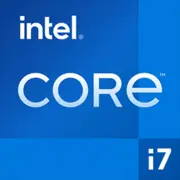Intel Core i7-11800H

インテル コア i7-11800H: ハイブリッドタスクのためのタイガーレイクの力
2025年4月現在
アーキテクチャとプロセス技術: 10nm SuperFinとマルチタスク対応の8コア
2021年に発売されたインテル コア i7-11800Hプロセッサは、バランスの取れたアーキテクチャのおかげで2025年にも現役です。これは10nmのSuperFin技術に基づいており、高密度のトランジスタとエネルギー効率を実現しています。主な仕様は以下の通りです。
- 8コアおよび16スレッド(ハイパースレッディング)で、ベースクロックは2.3GHz、ターボモードでは最大4.6GHz;
- 24MBのL3キャッシュ — 前世代のコメットレイク(i7-10875H)と比べて2倍;
- 第11世代インテル UHDグラフィックス、32 EU(演算ユニット)を備え、4K@60Hzをサポート。
アーキテクチャはウィロウコーブ(タイガーレイク-Hプラットフォームの一部)で、ゲームやプロフェッショナル向けのタスクに最適化されています。たとえば、PCIe 4.0のサポートにより、最大7GB/sの帯域幅を持つSSDを接続でき、ビデオ編集にとって重要です。内蔵GPUは、CS:GOのような軽めのゲームを処理できます(中設定で60-80 FPS)、しかしAAAタイトルには専用のグラフィックカードが必要です。
電力消費とTDP: 力とバッテリー寿命のバランス
プロセッサの公称TDPは35Wですが、ターボモードでは65–70Wに達する可能性があります。これには慎重な冷却システムが必要です。たとえば、2025年のASUS ZenBook Pro 15では、2つのファンを備えたハイブリッド冷却システムが使用され、負荷時の温度を85–90°Cに保っています。
アドバイス: i7-11800Hを搭載したノートパソコンを選ぶ際は、ケースの厚さにも注意してください。コンパクトなデバイス(たとえば、Dell XPS 15)では、過熱のためにプロセッサがスロットリングすることがあり、クロック周波数が3.8GHzまで低下します。ゲーミングモデル(MSI GP66)ではそのような問題は発生しません。
パフォーマンス: オフィスから4Kレンダリングまで
Geekbench 6は、チップの強みを示しています:
- シングルスレッドテストで1894ポイント — Apple M1 Pro(1850ポイント)のレベル;
- マルチスレッドで7864ポイント — AMD Ryzen 7 5800H(8100ポイント)にやや劣る。
実際のタスク:
- オフィス作業: Chromeで50以上のタブを開いても、ExcelやPhotoshopでの同時作業を行っても、プロセッサは応答性を保ちます。
- マルチメディア: 4Kでの10分のビデオレンダリング(Premiere Pro)には約12分を要し、i7-10750Hの約15分に対して優れた結果です。
- ゲーミング: RTX 3060と組み合わせたサイバーパンク2077(ウルトラ、DLSS)では、安定した60 FPSを実現。
ターボモードは短期間の負荷時(たとえば、ゲームの起動時)にアクティブになり、長期間のシナリオ(レンダリング)ではクロック周波数が10〜15%低下します。
利用シナリオ: i7-11800Hは誰に適しているか?
1. ゲーマー: RTX 3060以上のGPUと組み合わせることで、高いAI密度のゲーム(たとえば、ホライゾン・フォービドゥン・ウェスト)においてプロセッサの潜在能力を引き出します。
2. クリエイティブプロフェッショナル: 編集者や3Dデザイナーは、レンダリングの速度とThunderbolt 4のサポートを評価します。
3. 学生やハイブリッドユーザー: マルチタスクとWeb閲覧モードで最大8時間のバッテリーライフ。
例: Acer Predator Helios 300(i7-11800H + RTX 3070)は2025年に$1200–$1400で、ストリーミングや編集に適したモデルです。
バッテリー寿命: バッテリーはどのくらい持つか?
TDP 35Wの場合、作業内容によって稼働時間は大きく異なります:
- YouTube視聴(1080p): 6〜7時間(80Whのバッテリー);
- AutoCAD作業: 2.5〜3時間;
- Wi-Fiが有効なスリープモード: 最長10日間。
省エネルギー技術:
- Intel Speed Shift — エネルギー消費を削減するための動的クロック変更;
- Dynamic Tuning 2.0 — 熱条件に応じた適応。
重要: ウルトラブック(たとえば、HP Spectre x360)では、最適化されたBIOSや省電力ディスプレイによりバッテリー寿命が向上します(最大9時間)。
競合他社との比較:AMD、Apple、および前世代
- AMD Ryzen 7 5800H: マルチスレッドタスクで優れているが(+7%)、シングルスレッドでは劣っている(-10%)。価格は同等です。
- Apple M1 Pro: エネルギー効率が高く(18時間のバッテリー寿命)、ただしWindowsソフトウェアとの互換性に限界があります。
- インテル コア i7-12800H(アルダーレイク): マルチスレッドで20%速いが、価格は$200〜$300高いです。
2025年の結論: i7-11800Hは、価格とパフォーマンスのバランスを求める人にとって良い選択です。例えば、これを基にしたノートパソコンは現在$900–$1300の価格帯で、アルダーレイクの類似製品は$1400からです。
長所と短所: 2025年に購入する価値はあるか?
強み:
- ゲームやアプリケーションに対する高いシングルスレッド性能;
- PCIe 4.0およびThunderbolt 4のサポート;
- 中古や新しいデバイスのセグメントでの手ごろな価格。
短所:
- 長時間の負荷下での熱問題;
- 内蔵グラフィックスはAMD Radeon RX Vega 7よりも劣る;
- マルチスレッドでは新しいRyzen 7000に劣る。
ノートパソコン選びのポイント
1. ゲーミングノートパソコン: 効率的な冷却システム(熱管4本以上)と、RTX 3060以上のGPUを搭載したモデルを探してください。例: Lenovo Legion 5 Pro($1100–$1300)。
2. ワークステーション: 32GBのRAMと1TBのSSD(PCIe 4.0)が必須。推奨モデル: MSI Creator Z16($1500)。
3. ウルトラブック: 軽量(1.8kg未満)かつ高PPIのディスプレイを重視。Huawei MateBook X Pro (2025) が良い選択肢で、価格は$1300。
アドバイス: ノートパソコンがDDR4-3200MHzをサポートしていることを確認してください。これにより、プロセッサの性能が引き出されます。
最終結論: i7-11800Hは誰のために作られたか?
このプロセッサは、汎用性を必要とする人々に最適です:
- 限られた予算のゲーマー;
- グラフィックやコードを扱うフリーランサー;
- システムの応答性を重視するユーザー。
主な利点: 2025年の多くのタスクに必要なパワー、現代の標準との互換性、そしてコストパフォーマンスの最適なバランス。アルダーレイクやRyzen 7000に対して多額の車両を持たないのであれば、i7-11800Hは賢明な選択です。
基本
CPUの仕様
メモリ仕様
GPUの仕様
その他
ベンチマーク
他のCPUとの比較
ソーシャルメディアで共有する
または当サイトへのリンクを追加
<a href="https://cputronic.com/ja/cpu/intel-core-i7-11800h" target="_blank">Intel Core i7-11800H</a>